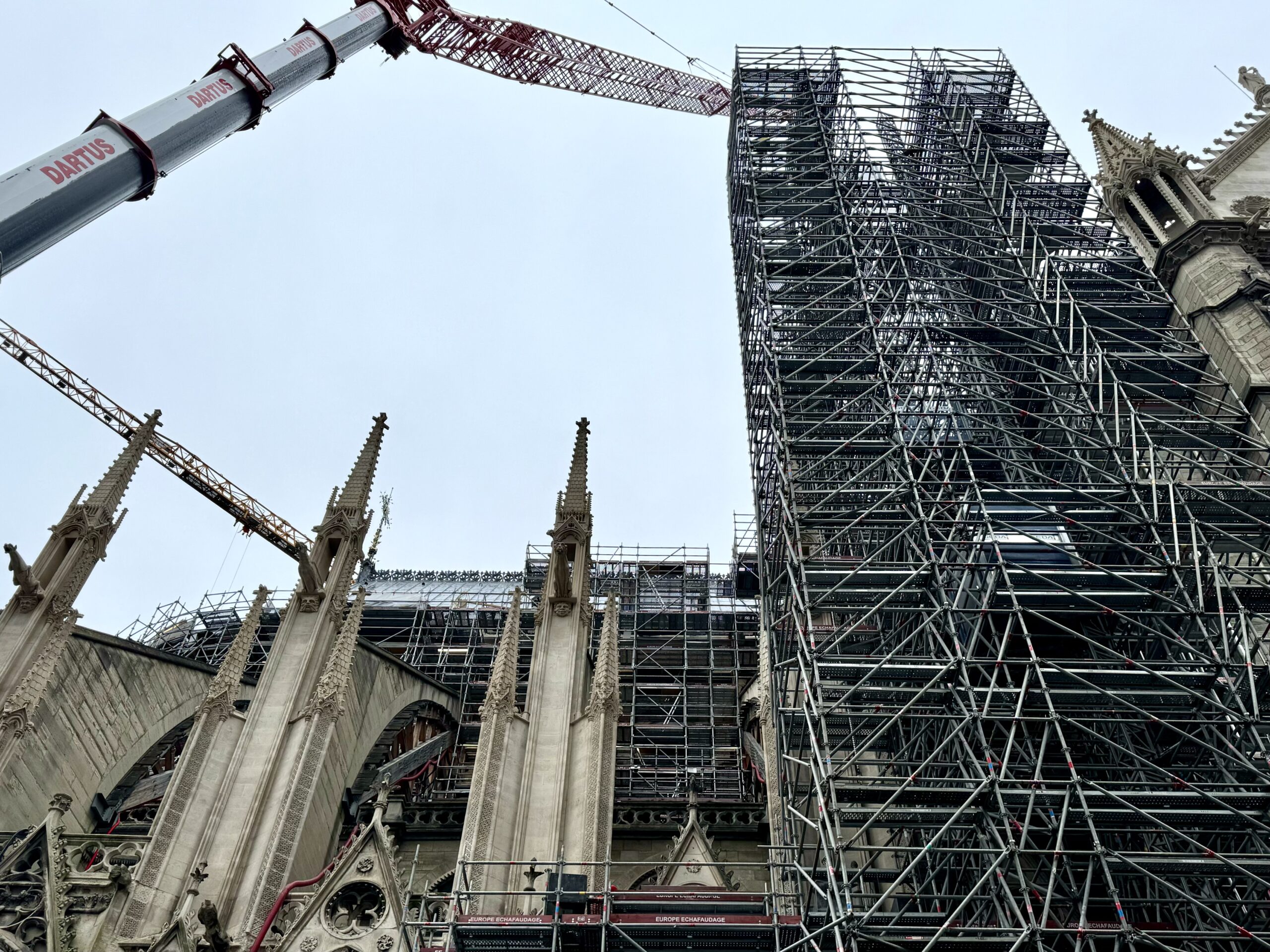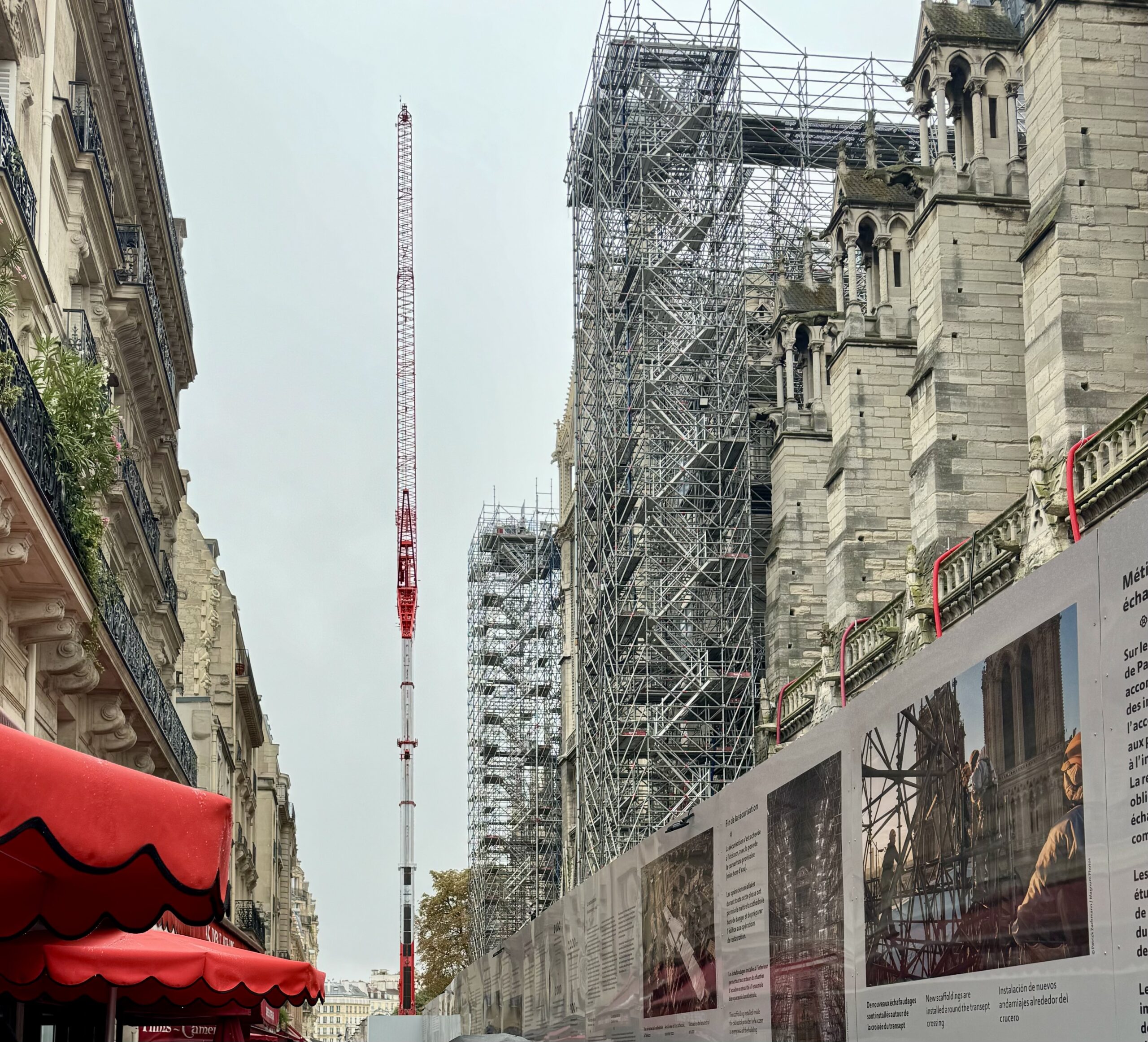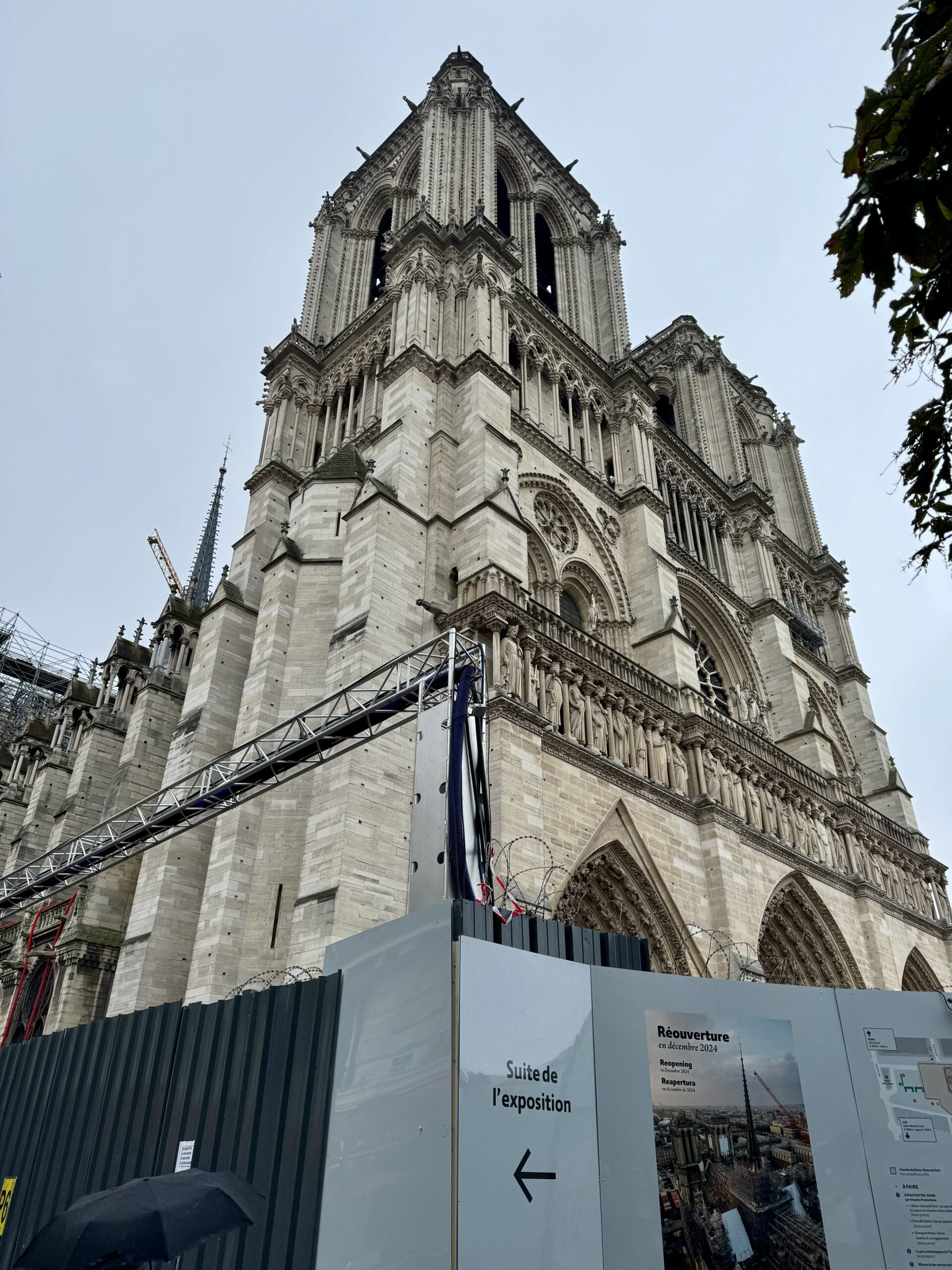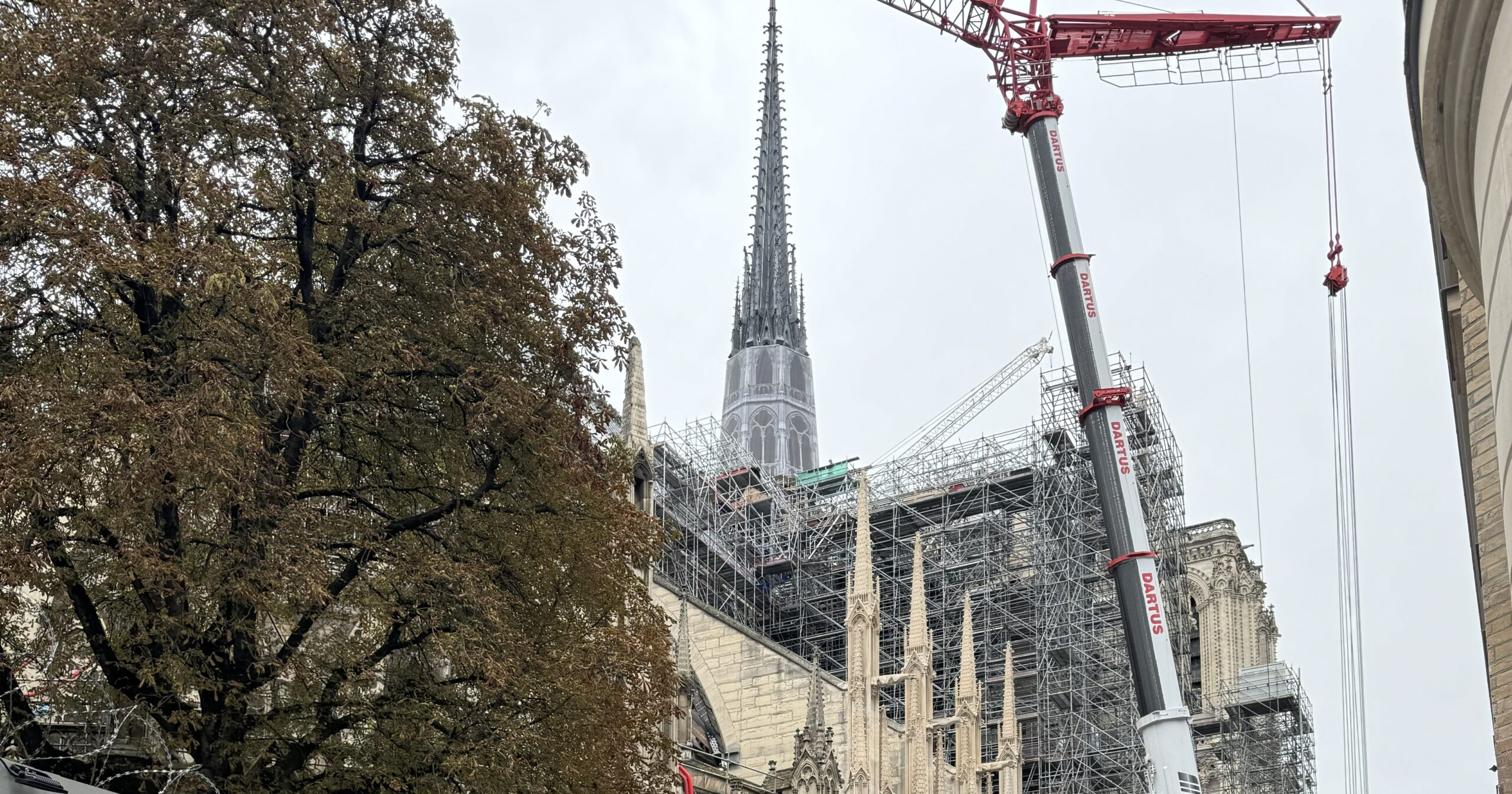Ema is a trained architect, writer and photographer who works as a Junior Architect at REX in NYC. Inspired by her global experiences, she shares captivating insights into the world’s most extraordinary cities and buildings and provides travel tips on her blog, The Travel Album.
Having just returned from Paris, I had the unique opportunity to witness the restoration efforts of the Notre Dame Cathedral firsthand. More than just a response to the tragic fire of 2019, the reconstruction of this iconic landmark has become an educational opportunity for visitors and Parisians alike. As scaffolding surrounds the once vibrant heart of this Gothic architecture, the city of Paris has created an informative journey around the closed-off cathedral, offering a window into both the past and future of Notre Dame.
What I truly appreciated about this approach was how the city turned the tragedy into an educational and informative experience for visitors and passersby. Instead of quietly reconstructing the building, they offered detailed insights into the cathedral’s history and the restoration process, including efforts to preserve its architectural integrity and historical significance. They also highlighted the proactive measures being taken to protect it from future disasters.
A Glimpse into the Past: The History of Notre Dame

Cathédrale Notre-Dame de Paris | Photo by Ema Bakalova
Notre Dame de Paris, a icon of French Gothic architecture, has stood as a symbol of Parisian culture, art and history since its foundation in 1163. Over the centuries, it has witnessed revolutions, wars and transformations, becoming a symbol not only of the Catholic Church but also of French national identity. The cathedral’s twin towers, rose windows and intricate façade are considered architectural marvels, with countless generations contributing to its ongoing preservation.
The fire of April 15, 2019, however, threatened to erase centuries of history. The blaze caused the collapse of the iconic spire and severely damaged the roof, shocking the world and igniting discussions about the fragility of cultural heritage. What emerged from this tragedy was not just sorrow but a global commitment to restore Notre Dame to its former glory. And now, the reconstruction effort has become a living lesson in history, architecture, and engineering.
I had completely forgotten about the Notre Dame reconstruction while in Paris, but as soon as I spotted the iconic twin towers near the Seine, it all came rushing back. That view drew me to the restoration site, and to my pleasant surprise, I discovered informative displays explaining the entire ongoing process, allowing me to learn a lot. It was a reminder of the cathedral’s enduring presence, even in the midst of its transformation.
The Restoration Timeline: From Tragedy to Rebirth

Cathédrale Notre-Dame de Paris | Photo by Ema Bakalova
The restoration of Notre Dame is progressing along a carefully structured timeline, driven by the desire to faithfully restore the cathedral while ensuring its resilience for future generations. Visitors can explore a timeline surrounding the cathedral, filled with informative text, images, photos and diagrams that outline the step-by-step process of the reconstruction, offering insight into the complexities involved in rebuilding such a historic structure. Immediately following the fire, the initial focus was on stabilizing the structure, ensuring that no further damage would occur. The removal of the melted scaffolding, installed during pre-fire renovation efforts, was a delicate and essential task that took months to complete. In the meantime, the process of cleaning the interior walls and stained glass windows began, revealing the beauty that lay beneath layers of soot and debris.
Current efforts are now focused on rebuilding the damaged roof and fully restoring the spire, designed by Eugène Viollet-le-Duc in the 19th century. Construction experts and historians have committed to using traditional materials and techniques as much as possible, echoing the craftsmanship of the original builders. Oak from sustainable forests across France has been selected for the roof’s timber frame, while artisans carefully recreate the intricate stone carvings and stained glass lost in the fire. The city brought in dozens of French craftsmen, each with specialized skills, to work on the various intricate aspects of the restoration project. The collaboration and the number of skilled workers involved is truly remarkable.
Strategy and Construction: A Balance of Tradition and Innovation


Cathédrale Notre-Dame de Paris | Photo by Ema Bakalova
While the guiding principle is to restore Notre Dame as faithfully as possible, modern construction techniques and technologies are being integrated to prevent future disasters. This balance of tradition and innovation is perhaps the most fascinating aspect of the restoration effort. To prevent the spread of fire, two full firewalls were installed to divide the attic and roof into three separate sections. The roof and spire are being rebuilt with a focus on fire prevention, incorporating advanced fireproofing materials that were unavailable in the past. Additionally, detection and sprinkler systems will be discreetly integrated into the structure to ensure that any future fire risks are minimized if high temperatures are detected. These modern safeguards are essential in ensuring that the cathedral will endure future challenges while preserving its authenticity.
One of the most educational aspects of the restoration effort is how it bridges the old with the new. Master craftsmen are applying medieval building techniques, while drone technology, 3D scanning and virtual modeling are being used to guide the reconstruction process. These advanced technologies allow experts to map out every detail of the cathedral and ensure that the restoration is as accurate as possible.
Educational Journey: Turning Restoration into Public Learning

Cathédrale Notre-Dame de Paris | Photo by Ema Bakalova
What sets this restoration effort apart is its accessibility to the public. As mentioned earlier, the city of Paris has transformed the perimeter of the closed cathedral into an open-air classroom for visitors, offering a unique educational experience.
This approach has allowed the public — the locals and the millions of visitors — to engage with and learn from the reconstruction process. This transparency not only educates visitors about the historical significance and architectural details of the cathedral, but it also fosters a deeper appreciation for the craftsmanship and effort involved in preserving such a cultural landmark. Additionally, it turns a tragedy into a teaching opportunity, highlighting modern restoration techniques and fire prevention measures while ensuring that Notre Dame’s legacy is accessible to future generations.
Safeguarding the Future: A Testament to Endurance

Cathédrale Notre-Dame de Paris | Photo by Ema Bakalova
Notre Dame’s restoration is not only about faithfully bringing back what was lost but also about preparing the cathedral for the future. The tragedy of the fire has prompted architects and engineers to think critically about how best to safeguard the building from future threats. While maintaining the historic authenticity of the cathedral, the incorporation of modern technologies ensures that Notre Dame will be better protected moving forward. The ongoing restoration of Notre Dame offers a profound example of how tragedy can be transformed into opportunity. What could have been a story of loss and destruction has instead become an inspiring tale of resilience, innovation and education. As Paris restores this iconic cathedral, it does so not only with a commitment to honoring the past but also with a vision for the future.
By incorporating modern technology, adhering to traditional craftsmanship and offering the public a rare educational experience, the restoration of Notre Dame is a testament to the enduring power of cultural heritage. In this unique intersection of history and innovation, the cathedral’s reconstruction stands as a symbol of hope and renewal, ensuring that Notre Dame will continue to inspire generations to come.
Architects: Want to have your project featured? Showcase your work through Architizer and sign up for our inspirational newsletters.




